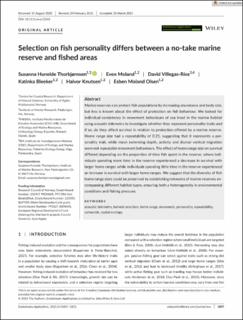| dc.contributor.author | Thorbjørnsen, Susanna Huneide | |
| dc.contributor.author | Moland, Even | |
| dc.contributor.author | Villegas-Ríos, David | |
| dc.contributor.author | Bleeker, Katinka | |
| dc.contributor.author | Knutsen, Halvor | |
| dc.contributor.author | Olsen, Esben Moland | |
| dc.date.accessioned | 2021-08-17T09:48:35Z | |
| dc.date.available | 2021-08-17T09:48:35Z | |
| dc.date.created | 2021-07-23T18:01:22Z | |
| dc.date.issued | 2021 | |
| dc.identifier.citation | Evolutionary Applications. 2021, 1-9. | en_US |
| dc.identifier.issn | 1752-4571 | |
| dc.identifier.uri | https://hdl.handle.net/11250/2768753 | |
| dc.description.abstract | Marine reserves can protect fish populations by increasing abundance and body size, but less is known about the effect of protection on fish behaviour. We looked for individual consistency in movement behaviours of sea trout in the marine habitat using acoustic telemetry to investigate whether they represent personality traits and if so, do they affect survival in relation to protection offered by a marine reserve. Home range size had a repeatability of 0.21, suggesting that it represents a personality trait, while mean swimming depth, activity and diurnal vertical migration were not repeatable movement behaviours. The effect of home range size on survival differed depending on the proportion of time fish spent in the reserve, where individuals spending more time in the reserve experienced a decrease in survival with larger home ranges while individuals spending little time in the reserve experienced an increase in survival with larger home ranges. We suggest that the diversity of fish home range sizes could be preserved by establishing networks of marine reserves encompassing different habitat types, ensuring both a heterogeneity in environmental conditions and fishing pressure. | en_US |
| dc.language.iso | eng | en_US |
| dc.title | Selection on fish personality differs between a no-take marine reserve and fished areas | en_US |
| dc.type | Peer reviewed | en_US |
| dc.type | Journal article | en_US |
| dc.description.version | publishedVersion | en_US |
| dc.source.pagenumber | 1-9 | en_US |
| dc.source.journal | Evolutionary Applications | en_US |
| dc.identifier.doi | 10.1111/eva.13242 | |
| dc.identifier.cristin | 1922513 | |
| dc.relation.project | EC/H2020/793627 | en_US |
| dc.relation.project | EC/FP7/225592 | en_US |
| dc.relation.project | Norges forskningsråd: 201917 | en_US |
| cristin.ispublished | true | |
| cristin.fulltext | original | |
| cristin.qualitycode | 2 | |
